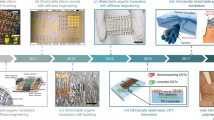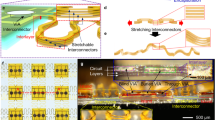Abstract
Stretchable electronics is an emerging technology that creates devices with the ability to conform to nonplanar and dynamic surfaces such as the human body. Current stretchable configurations are constrained to single-layer designs due to limited material processing capabilities in soft electronic systems. Here we report a framework for engineering three-dimensional integrated stretchable electronics by combining strategies in material design and advanced microfabrication. Our three-dimensional devices are built layer by layer through transfer printing pre-designed stretchable circuits on elastomers and creating vertical interconnect accesses using laser ablation and controlled soldering. Our approach enables a higher integration density on stretchable substrates than single-layer approaches and allows new functionalities that would be difficult to implement with conventional single-layer designs. Using this engineering framework, we create a stretchable human–machine interface testbed that is based on a four-layer design and offers eight-channel sensing and Bluetooth data communication capabilities.
This is a preview of subscription content, access via your institution
Access options
Access Nature and 54 other Nature Portfolio journals
Get Nature+, our best-value online-access subscription
$29.99 / 30 days
cancel any time
Subscribe to this journal
Receive 12 digital issues and online access to articles
$119.00 per year
only $9.92 per issue
Buy this article
- Purchase on Springer Link
- Instant access to full article PDF
Prices may be subject to local taxes which are calculated during checkout




Similar content being viewed by others
References
Kim, D.-H. et al. Epidermal electronics. Science 333, 838–843 (2011).
Lee, H. et al. A graphene-based electrochemical device with thermoresponsive microneedles for diabetes monitoring and therapy. Nat. Nanotech. 11, 566–572 (2016).
Miyamoto, A. et al. Inflammation-free, gas-permeable, lightweight, stretchable on-skin electronics with nanomeshes. Nat. Nanotech. 12, 907–913 (2017).
Wirthl, D. et al. Instant tough bonding of hydrogels for soft machines and electronics. Sci. Adv. 3, e1700053 (2017).
Keplinger, C. et al. Stretchable, transparent, ionic conductors. Science 341, 984–987 (2013).
Oh, J. Y. et al. Intrinsically stretchable and healable semiconducting polymer for organic transistors. Nature 539, 411–415 (2016).
Ota, H. et al. Highly deformable liquid-state heterojunction sensors. Nat. Commun. 5, 5032 (2014).
Kim, C.-C., Lee, H.-H., Oh, K. H. & Sun, J.-Y. Highly stretchable, transparent ionic touch panel. Science 353, 682–687 (2016).
White, M. S. et al. Ultrathin, highly flexible and stretchable PLEDs. Nat. Photon. 7, 811–816 (2013).
Jung, Y. H. et al. Stretchable twisted-pair transmission lines for microwave frequency wearable electronics. Adv. Funct. Mater. 26, 4635–4642 (2016).
Liu, Y. et al. Epidermal mechano-acoustic sensing electronics for cardiovascular diagnostics and human–machine interfaces. Sci. Adv. 2, e1601185 (2016).
Jeong, J.-W. et al. Materials and optimized designs for human–machine interfaces via epidermal electronics. Adv. Mater. 25, 6839–6846 (2013).
Lim, S. et al. Transparent and stretchable interactive human machine interface based on patterned graphene heterostructures. Adv. Funct. Mater. 25, 375–383 (2015).
Rogers, J. A., Someya, T. & Huang, Y. Materials and mechanics for stretchable electronics. Science 327, 1603–1607 (2010).
Choi, S., Lee, H., Ghaffari, R., Hyeon, T. & Kim, D. H. Recent advances in flexible and stretchable bio-electronic devices integrated with nanomaterials. Adv. Mater. 28, 4203–4218 (2016).
Xu, S. et al. Soft microfluidic assemblies of sensors, circuits, and radios for the skin. Science 344, 70–74 (2014).
Zhang, Y. et al. A hierarchical computational model for stretchable interconnects with fractal-inspired designs. J. Mech. Phys. Solids 72, 115–130 (2014).
Gonzalez, M. et al. Design of metal interconnects for stretchable electronic circuits. Microelectron. Reliab. 48, 825–832 (2008).
Fan, Z. et al. A finite deformation model of planar serpentine interconnects for stretchable electronics. Int. J. Solids Struct. 91, 46–54 (2016).
Ma, Y. et al. Soft elastomers with ionic liquid‐filled cavities as strain isolating substrates for wearable electronics. Small 13, 1602954 (2017).
Li, J. et al. Tough adhesives for diverse wet surfaces. Science 357, 378–381 (2017).
Itzkan, I. et al. The thermoelastic basis of short pulsed laser ablation of biological tissue. Proc. Natl Acad. Sci. USA 92, 1960–1964 (1995).
Haynes, W. M. (ed.) CRC Handbook of Physics and Chemistry (CRC Press, Boca Raton, 2014).
Gattass, R. R. & Mazur, E. Femtosecond laser micromachining in transparent materials. Nat. Photon. 2, 219–225 (2008).
Kim, T. N., Campbell, K., Groisman, A., Kleinfeld, D. & Schaffer, C. B. Femtosecond laser-drilled capillary integrated into a microfluidic device. Appl. Phys. Lett. 86, 201106 (2005).
Lee, T.-I., Kim, M. S. & Kim, T.-S. Contact-free thermal expansion measurement of very soft elastomers using digital image correlation. Polym. Test. 51, 181–189 (2016).
Xu, S. et al. Stretchable batteries with self-similar serpentine interconnects and integrated wireless recharging systems. Nat. Commun. 4, 1543 (2013).
Byun, J. et al. A single droplet-printed double-side universal soft electronic platform for highly integrated stretchable hybrid electronics. Adv. Funct. Mater. 27, 1701912, (2017).
Pfurtscheller, G. Event-related synchronization (ERS): an electrophysiological correlate of cortical areas at rest. Electroencephalogr. Clin. Neurophysiol. 83, 62–69 (1992).
Garcia-Rill, E. et al. The 10 Hz frequency: A fulcrum for transitional brain states. Transl. Brain Rhythmicity 1, 7–13 (2016).
Ramos, J., Wang, A., Ubellacker, W., Mayo, J. & Kim, S. A balance feedback interface for whole-body teleoperation of a humanoid robot and implementation in the HERMES system. 2015 IEEE-RAS 15th Int. Conf. Humanoid Robots (Humanoids) https://doi.org/10.1109/HUMANOIDS.2015.7363460 (2015).
Ma, J., Zhang, Y., Cichocki, A. & Matsuno, F. A novel EOG/EEG hybrid human–machine interface adopting eye movements and ERPs: application to robot control. IEEE T. Bio-med. Eng. 62, 876–889 (2015).
Brosteaux, D., Axisa, F., Gonzalez, M. & Vanfleteren, J. Design and fabrication of elastic interconnections for stretchable electronic circuits. IEEE Electron Device Lett. 28, 552–554 (2007).
Yang, S., Ng, E. & Lu, N. Indium tin oxide (ITO) serpentine ribbons on soft substrates stretched beyond 100%. Extreme Mech. Lett. 2, 37–45 (2015).
Lee, C. H. et al. Soft core/shell packages for stretchable electronics. Adv. Funct. Mater. 25, 3698–3704 (2015).
Lee, T. et al. Fabrication of flexible, transparent and conductive films from single-walled carbon nanotubes with high aspect ratio using poly((furfuryl methacrylate)-co-(2-(dimethylamino)ethyl methacrylate)) as a new polymeric dispersant. Nanoscale 7, 6745–6753 (2015).
Acknowledgements
The project described was partially supported by the UC San Diego Center for Wearable Sensors, Center for Healthy Aging, Contextual Robotics Institute, and the National Institutes of Health Grant UL1TR001442 of CTSA funding. The content is solely the responsibility of the authors and does not necessarily represent the official views of the NIH. We thank R. L. Sah’s group for assistance with the XCT measurements, M. Tolley for discussions on robot control, Z. Zhang for his contribution on data analysis, M. Li for discussions on Bluetooth, M. Makihata for discussions on the antenna test and S. Xiang for her constructive feedback on manuscript preparation.
Author information
Authors and Affiliations
Contributions
Z.H. and S.X. designed the experiments. Z.H., Y.H. and Y.Li carried out experiments. All authors contributed to analysing the data. Z.H. and S.X. wrote the paper, on which all authors provided valuable feedback.
Corresponding author
Ethics declarations
Competing interests
The authors declare no competing interests.
Additional information
Publisher’s note: Springer Nature remains neutral with regard to jurisdictional claims in published maps and institutional affiliations.
Supplementary information
Supplementary Information
Supplementary Notes 1–9 and Supplementary Figures 1–63
Rights and permissions
About this article
Cite this article
Huang, Z., Hao, Y., Li, Y. et al. Three-dimensional integrated stretchable electronics. Nat Electron 1, 473–480 (2018). https://doi.org/10.1038/s41928-018-0116-y
Received:
Accepted:
Published:
Issue Date:
DOI: https://doi.org/10.1038/s41928-018-0116-y
This article is cited by
-
Multilayer stretchable electronics with designs enabling a compact lateral form
npj Flexible Electronics (2024)
-
Frequency-encoded eye tracking smart contact lens for human–machine interaction
Nature Communications (2024)
-
Intelligent perceptual textiles based on ionic-conductive and strong silk fibers
Nature Communications (2024)
-
Adaptive tactile interaction transfer via digitally embroidered smart gloves
Nature Communications (2024)
-
Full integration of highly stretchable inorganic transistors and circuits within molecular-tailored elastic substrates on a large scale
Nature Communications (2024)



